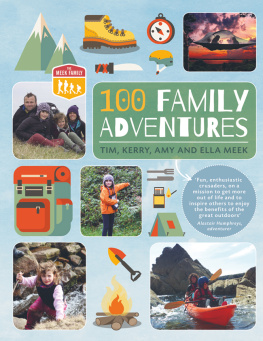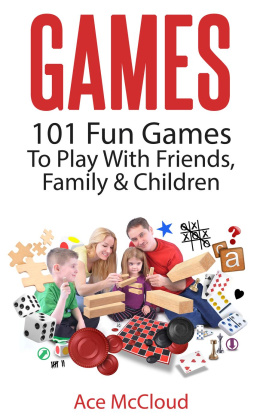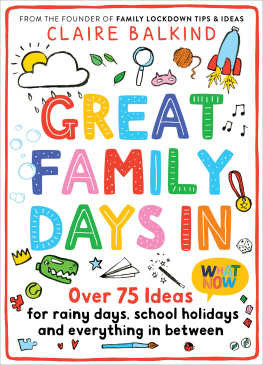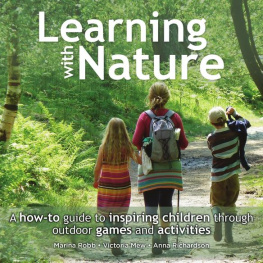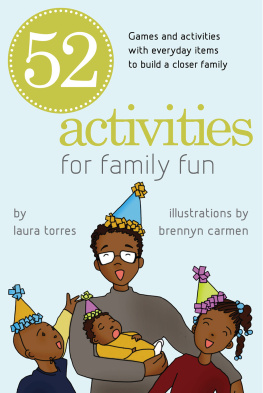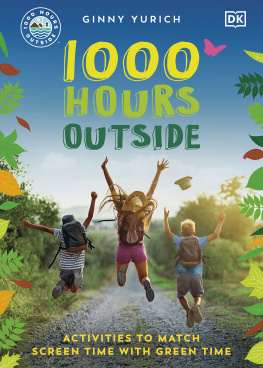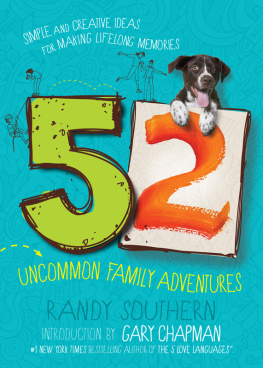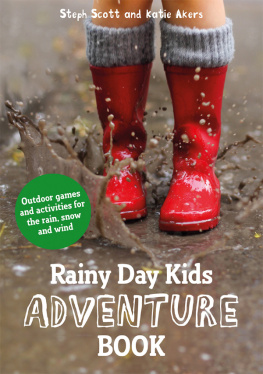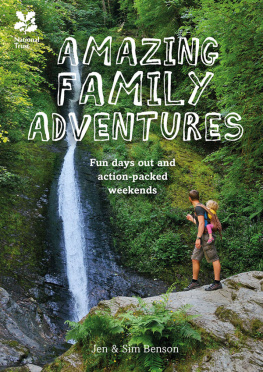100 FAMILY
ADVENTURES

CONTENTS
The idea for 100 Family Adventures grew from wanting to spend more quality family time outdoors walking, cycling, kayaking simply doing things together as a family.
We were worried about our time-pressured lifestyle that persistently put a squeeze on our family time. We didnt want our children to grow up molly-coddled and wrapped up in cotton wool, preferring to spend their time indoors in front of a TV or computer screen rather than enjoying the great outdoors. We wanted them, instead, to be connected to nature as well as technology and to balance their screen time with plenty of green time. It is our hope that they grow up as bold individuals who grasp opportunities and who look for adventure and fulfillment in life.
So what is adventure? Well, it can be whatever you want it to be; but to us, adventure is all about pushing your comfort zones, trying new activities, or doing familiar activities in different ways. But remember, adventure is personal and there are no rights or wrongs you can come up with your own definition.
The 100 adventures in this book are designed to encourage other families to get out and do things together, to help adults and children alike to push their own comfort zones even if it is just a little. They are sorted into categories, for ease of reference, but are not presented in any particular order, so you can tackle them however suits you best.
Everyone loves a list, so we have organized the adventures as a checklist on the contents page so that you can find them in the book and also tick them off as you complete them, allowing you to keep a record of how many you do.
As a family, and as individuals, we feel happier being outdoors and spending time together. And what better way to get to know your children, and yourself, than by sharing the thrill and excitement of a family adventure?
Now its over to you. Adventure is out there you just have to go and find it!
TIM, KERRY, AMY AND ELLA
The Meek Family


Learn some bushcraft skills such as building a shelter, cooking in the open air or making something from nothing. How about walking high among the treetops, sleeping in a log cabin or undertaking a night walk, in the company of nocturnal creatures like owls and rabbits?
Learn some bushcraft skills and become at one with nature.
Shelter is one of the five basic human needs for survival and wellbeing. It provides us with protection from the elements and helps us with temperature regulation. While it is unlikely that you and your children are going to be building a shelter on which your survival depends, at least not in the short term, this project is a valuable exercise. For children, the experience of creating their own shelter allows them to appreciate that their counterparts around the world are not all necessarily fortunate enough to have these basic needs met.
That said, you can be confident that all involved in the exercise of building a homemade shelter will find it an enjoyable and rewarding experience.
Here are some different types of shelter to build:
SIMPLE TARPAULIN TENT
By using a piece of tarpaulin with guy ropes, two walking poles and a handful of pegs, you can make an effective tent. The size of the tarpaulin determines how many people you can home. This tent (right) was made from a kids shelter-building set and can be adapted to make a wide range of different shapes and sizes.
TARPAULIN AND HAMMOCK
This is a slightly more technical shelter to build, as it requires more equipment (a rope, tarpaulin and guys, pegs and a hammock), but is really not difficult to set up. String a rope between two trees (to act as a ridge pole), drape the tarpaulin over it and peg it down using long guy ropes; this is the canopy or roof. Then suspend the hammock under the canopy, making sure it is flat and taut.
TIPS AND CONSIDERATIONS
| When building shelters in the wild, try not to chop down or break any living vegetation; encourage children to respect the living world. |
| Children of all ages love to make dens and hideouts. Encourage this by giving them space and time in the outdoors, and help them get started by choosing a good location and suggesting a source of building materials. |
| Den building kits such as Kidcampz are useful aids for creative den building and are ideal for indoor and outdoor environments. |
DID YOU KNOW?
The oldest tree in the world is the Great Basin Bristlecone Pine from California.
AMY SAYS
SIMPLE DEN When we make a den outside, we take two Y-shaped sticks and place them about 2m/2yds apart on a gentle slope, then join them together with another stick. Next, we stack twigs onto the gently sloped sticks and when weve worked up a sturdy base, we pile some bracken on top. Here (left) is a den we made together when we were younger
LEAF SPOTTING In the woods gather up some different types of leaves that are lying on the ground. Next search for various trees (with their leaves on) and try to identify the trees that the leaves came from.

ELLAS JOKE
Why was the ladybird kicked out of the forest?
Because she was a litterbug!
Another basic need that we humans have is food; we need to eat regularly and healthily in order to stay fit and well. There are several bushcraft skills associated with cooking on a fire that you can introduce to children, but the first thing you have to do is create a flame.
DID YOU KNOW?
Clovers are actually edible and can be eaten to help you survive in the wild!
WAYS TO CREATE A FLAME
MATCHES Waterproof and windproof matches provide a quick, reliable solution.
LIGHTER FLINTS These fire starters are cheap, reliable and compact. A knife blade can be used to create friction on the sparking stick. Children can use them safely.
DRILL AND BOW A classic tool used to create a flame by friction. It is quite technical to make and use, so therefore not ideal for children.
CREATING A FIRE
The sparks you create need to fall on and ignite into some dry kindling material such as dried grass, cotton wool or birch bark shavings. Ideally the kindling should be placed on a platform of thin wood. Once you have a flame, start laying down small twigs in a criss-cross formation over the flames so that oxygen will be able to flow through the gaps in the twigs. As the twigs catch fire and the smoke increases, keep piling twigs onto the flames until you are happy with your fire.
SAFETY
Children must always be supervised and behave sensibly near fires. They should also avoid getting too close to the flames, especially if wearing fleecy clothing that is highly flammable. Make sure the supervising adult knows how to safely start, manage and put out fires, and that someone is first-aid trained. It is best to have a bucket of water close to hand for putting out a fire in an emergency.

